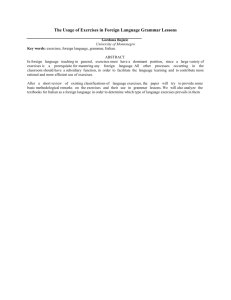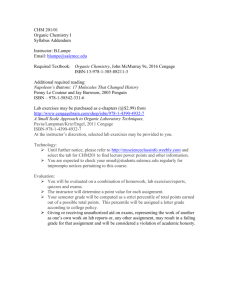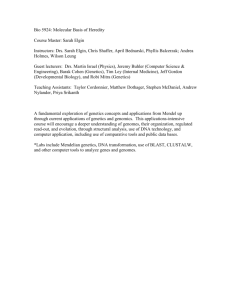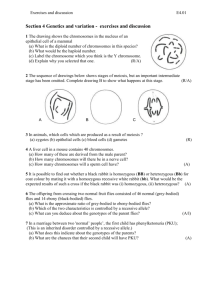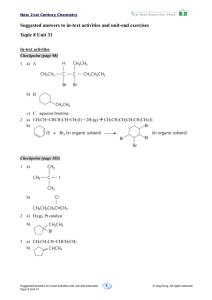LAB 1: INTRODUCTION TO THE COURSE
advertisement
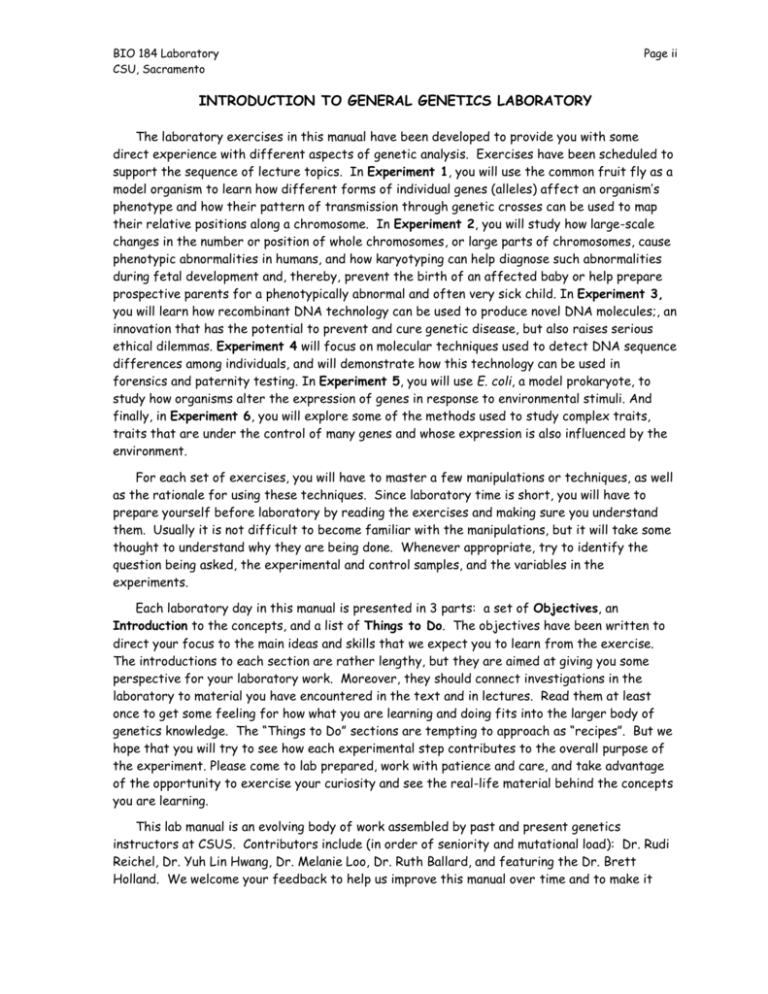
BIO 184 Laboratory CSU, Sacramento Page ii INTRODUCTION TO GENERAL GENETICS LABORATORY The laboratory exercises in this manual have been developed to provide you with some direct experience with different aspects of genetic analysis. Exercises have been scheduled to support the sequence of lecture topics. In Experiment 1, you will use the common fruit fly as a model organism to learn how different forms of individual genes (alleles) affect an organism’s phenotype and how their pattern of transmission through genetic crosses can be used to map their relative positions along a chromosome. In Experiment 2, you will study how large-scale changes in the number or position of whole chromosomes, or large parts of chromosomes, cause phenotypic abnormalities in humans, and how karyotyping can help diagnose such abnormalities during fetal development and, thereby, prevent the birth of an affected baby or help prepare prospective parents for a phenotypically abnormal and often very sick child. In Experiment 3, you will learn how recombinant DNA technology can be used to produce novel DNA molecules;, an innovation that has the potential to prevent and cure genetic disease, but also raises serious ethical dilemmas. Experiment 4 will focus on molecular techniques used to detect DNA sequence differences among individuals, and will demonstrate how this technology can be used in forensics and paternity testing. In Experiment 5, you will use E. coli, a model prokaryote, to study how organisms alter the expression of genes in response to environmental stimuli. And finally, in Experiment 6, you will explore some of the methods used to study complex traits, traits that are under the control of many genes and whose expression is also influenced by the environment. For each set of exercises, you will have to master a few manipulations or techniques, as well as the rationale for using these techniques. Since laboratory time is short, you will have to prepare yourself before laboratory by reading the exercises and making sure you understand them. Usually it is not difficult to become familiar with the manipulations, but it will take some thought to understand why they are being done. Whenever appropriate, try to identify the question being asked, the experimental and control samples, and the variables in the experiments. Each laboratory day in this manual is presented in 3 parts: a set of Objectives, an Introduction to the concepts, and a list of Things to Do. The objectives have been written to direct your focus to the main ideas and skills that we expect you to learn from the exercise. The introductions to each section are rather lengthy, but they are aimed at giving you some perspective for your laboratory work. Moreover, they should connect investigations in the laboratory to material you have encountered in the text and in lectures. Read them at least once to get some feeling for how what you are learning and doing fits into the larger body of genetics knowledge. The “Things to Do” sections are tempting to approach as “recipes”. But we hope that you will try to see how each experimental step contributes to the overall purpose of the experiment. Please come to lab prepared, work with patience and care, and take advantage of the opportunity to exercise your curiosity and see the real-life material behind the concepts you are learning. This lab manual is an evolving body of work assembled by past and present genetics instructors at CSUS. Contributors include (in order of seniority and mutational load): Dr. Rudi Reichel, Dr. Yuh Lin Hwang, Dr. Melanie Loo, Dr. Ruth Ballard, and featuring the Dr. Brett Holland. We welcome your feedback to help us improve this manual over time and to make it BIO 184 Laboratory CSU, Sacramento Page iii more informative and student-friendly. GENERAL GENETICS LABORATORY RULES AND SAFETY PRECAUTIONS During the semester we will be working with several potentially hazardous materials and pieces of equipment. Please pay special attention to the following precautions. 1. Read laboratory exercises before you come to class and be aware of potential hazards. These include the handling of ethanol, acids, ethidium bromide, ultraviolet radiation, electricity, bunsen burners, toluene, and bacteria. 2. Know the location of the fire extinguisher at the front of the laboratory. Minimize risks of fires by keeping long hair tied back and flammable materials (tissues, ethanol, clothing) away from bunsen burner flames. If ethanol should ignite, cover the container. If clothing ignites, use the fire blanket that hangs on the side of the front bench to smother the flames and/or roll the victim on the floor. 3. Handle glassware carefully and carry test tubes in the racks provided. Broken glass should be deposited in the "sharps" containers. Dirty glassware should have labels removed and be deposited in the wire mesh baskets at the back of the room. Dirty pipettes should be placed in the pipette washers, tip down. If you break glass, a dustpan and a whisk broom are available in the technician’s lab across the hall. A First Aid kit is also located there in case you cut yourself. Deep or large cuts should be reported to the lab instructor immediately. 4. Discard disposable culture containers, like plastic Petri dishes, in the orange hazardous waste bag at the back of the room, so that they can be autoclaved before disposal. 5. Always wear shoes in the laboratory, preferably of the closed-toe type. 6. Return stock cultures and reagents to the area from which they were obtained. Do not return used stocks to the stock bottles, to avoid the risk of contaminating stocks. 7. Discard trash in the trash cans; do not leave it on the desk or in the sink. 8. Do not eat or drink in the laboratory. 9. Come to lab on time and ready to work. Keep a good record of what you have done and seen, to be used for future reference.





